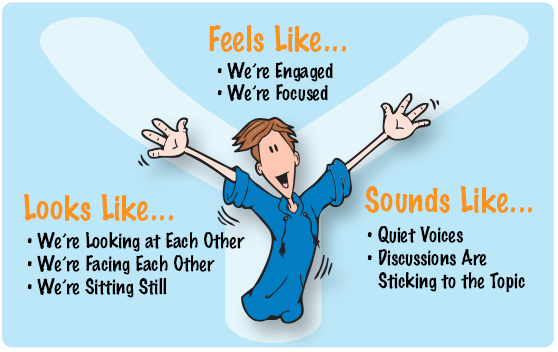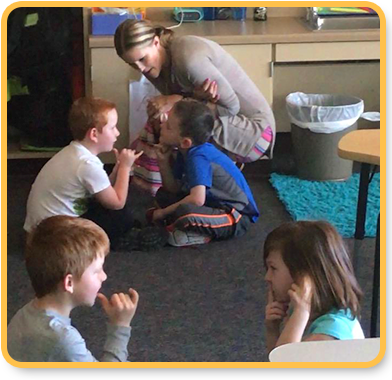Kagan's Articles - FREE Kagan Articles
Articles by Dr. Vern Minor
Varying Volumes
Teacher & Training Tips
Varying Volumes
Rick DuVall, Ph.D.

To cite this article: DuVall, R. Varying Volumes, San Clemente, CA: Kagan Publishing. Kagan Online Magazine, Issue #60. www.KaganOnline.com
A problem that some teachers encounter when implementing Kagan Structures for active engagement is that their students don’t know how to differentiate their speaking volumes, and the noise level becomes problematic when implementing a structure. When students don’t know how to do something, preventing them from doing that thing doesn’t help them learn how to do it. In fact, quite the opposite is true; if we avoid having students do what they’re unable to do, those students will leave our classrooms at the end of the school year still not knowing how to do it. When it comes to adjusting the volume of our voices, I find this is extremely true. Just think about real-life scenarios:
- You’re trying to listen to a speaker in a large group setting and he’s speaking so softly that you find it difficult to hear him. Quickly you lose focus and become disengaged.
- You’re in a restaurant and can hear the conversations that people are engaged in three tables away from you. You find it hard to enjoy your meal because of the distracting conversations.
- You’re watching a movie in a theater with a friend. You whisper something to her, and she loudly responds to you. People several rows around you annoyingly stare at you. You’re so embarrassed that you vow to not go to the movies with this friend again anytime soon.
- Someone is in an emergency situation outdoors but doesn’t know how to get other people’s attention for help. It takes a considerable amount of time before anyone knows that there is a severe problem, thereby escalating the emergency situation.
To successfully engage in Kagan Structures, our students need to learn how to adjust their volumes, primarily in the following four ways:
- Partner Voices
- Team Voices
- Whole-Class Voices
- Outside Voices
If volume is problematic when implementing a Kagan Structure, please don’t avoid doing the structure. We don’t want students to grow up never learning how to vary their speaking volumes. Instead, view the inappropriate volume as formative assessment that informs you that the students need instruction, practice, and reflection on how to vary their volumes.
Y-Charts
Have students use a Kagan Structure such as Both Record RallyRobin to brainstorm what it should look like, what it should sound like, and how it should feel when we’re working with a partner in our classroom.

After all students have brainstormed and recorded several ideas under each of the three headings, utilize a Kagan Structure such as Stand-N-Share to have partners share with the class what they brainstormed. If you can agree to what they say, record it on a class anchor chart. Post this chart and refer to it as a frequent reminder before implementing Kagan Structures.
We can utilize Kagan Structures such as RoundTable Consensus to develop similar Y-charts for team voices, whole-class voices, and outside voices.
Model
Demonstrate how an appropriate partner voice should be able to be heard clearly by our partner, but not by anyone else. Have a student volunteer help model this. Instruct everyone (including the volunteer) to give you a thumbs-up if they clearly can understand what you’re saying. They should hold up a flat hand if they possibly can hear a light buzz and are aware that you’re talking but are unable to make out what you’re saying. Celebrate if your partner gives you a thumbs-up and everyone else in class holds up a flat hand. If your partner can’t hear you, explain that you will need to try it again slightly louder. Likewise, if other students indicate that they can hear you clearly, explain that you will need to try it again slightly more softly. Utilize the Kagan Structure RoundRobin to have everyone in class practice a partner voice, instructing Teammate #1 to talk to his or her shoulder partner (where Teammate #2 should be holding a thumbs-up while Teammates #3 and #4 should be holding up a flat hand). They keep practicing until all teammates can successfully use a partner voice.
We can repeat this process for team voices, taking turns with each team doing a RoundRobin in front of the class. This should result in three teammates giving the speaker a thumbs-up while the members of the other teams are holding up a flat hand.
For whole-class voices, have students stand and say something to the class. Students are successful when everyone in class gives them a thumbs-up. We can take our students outside to practice outside voices.
Kinesthetic Symbols
Some teachers, especially those working with very young children, find it helpful to teach students to hold up a kinesthetic symbol that corresponds with the appropriate volume level each time they implement a structure.
- For Kagan Structures with pairs, have each student place a thumb on their chin with their other fingers extended toward their partner. Remind them that a partner voice should be slightly above a whisper so that only the listening partner can hear. The listening partner cups one hand around one of their ears, while they place the index finger from their other hand over their lips in a “Shh!” position. Whitney Sturman, a phenomenal first-grade teacher at Baggs Elementary in Cheyenne, Wyoming, refers to this with her students as a six-inch voice, where students have learned that this voice should be an extremely quiet voice.
 Whitney Sturman monitors her first-graders as they engage
Whitney Sturman monitors her first-graders as they engage
in a Timed Pair Share using six-inch voices. - For Kagan Structures with teams, have each student extend one arm straight out in front of themselves. Remind the students that a team voice should be a soft voice so that only the people sitting at your table can hear. We might refer to this as a yard-stick voice.
- For Kagan Structures where we’re asking students to share ideas with the entire class, have students stand up and hold both arms out at shoulder-level, as far as they can extend. Remind students that a whole-class voice easily should be heard by everyone in class. We might refer to this as an auditorium voice.
- For some Silly Sports and Goofy Games, when we need students to make loud noises, we take students outside and have them cup both hands around their mouths, mimicking screaming. Remind students that an outside voice should be heard by people quite a distance away. We probably will want to refer to this as an outside voice (and use very sparingly!)
Practice Regularly
Implement Kagan Structures regularly and remind students of the appropriate volume that the structure demands. As with most skills, managing voice levels is something that must be practiced often before it becomes automatic. Once mastered, though, successfully implementing Kagan Structures becomes much easier and more effective—simultaneously increasing active engagement in our classrooms while keeping students calm, positive, and focused on learning.
Related Resource
 |
Yacker Tracker |